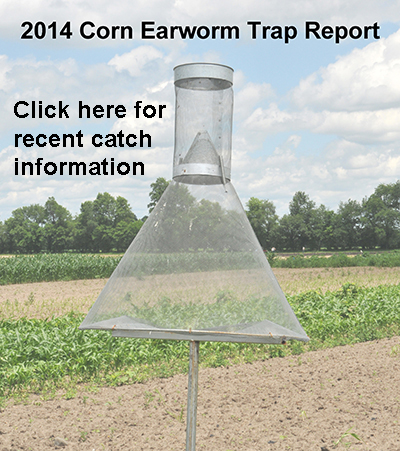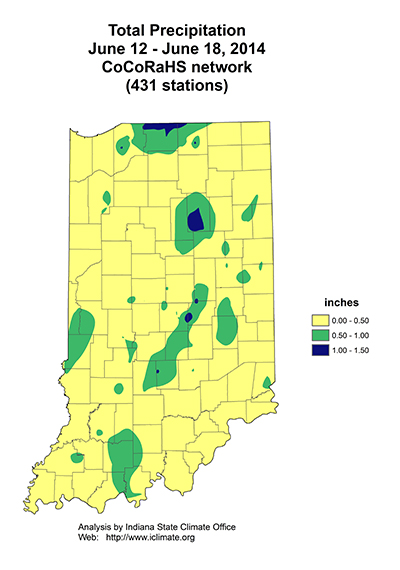USDA-NIFA Extension IPM Grant
Pest & Crop Newsletter, Entomology Extension, Purdue University
- Potato Leafhopper Numbers Increasing
- 2014 Corn Earworm Trap Report
- Armyworm Pheromone Trap Report
Potato Leafhopper Numbers Increasing - (John Obermeyer and Christian Krupke)
• Sample newly cut alfalfa fields for leafhoppers.
• If yellowing has already occurred, it is too late to prevent damage to this cutting.
• Management guidelines are given.
Potato leafhopper populations will be increasing with warmer temperatures we are having. Alfalfa pest managers should begin sampling their alfalfa shortly after cutting.
Potato leafhoppers are small, wedge-shaped, yellowish-green insects that remove plant sap with their piercing-sucking mouthparts. Leafhopper feeding will often cause the characteristic wedge-shaped yellow area at the leaf tip, which is referred to as “hopper burn.” Widespread feeding damage can cause a field to appear yellow throughout. Leafhopper damage reduces yield and forage quality through a loss of protein. If left uncontrolled for several cuttings, potato leafhoppers can also significantly reduce stands.
Timely scouting and applying insecticides when necessary can prevent potato leafhopper damage. Treatment is preventative rather than curative. Thus, to effectively prevent economic losses, treatments must be applied before yellowing occurs. Be sure to scout the alfalfa regrowth for leafhoppers shortly after cutting and removal, as this is one of the more critical periods.
The need to treat for leafhoppers can be determined prior to the appearance of damage if fields are surveyed on a regular basis. To assess leafhopper populations and the potential for damage, take at least 5 sets of 20 sweeps with a 15” diameter sweep net in representative areas of a field. Carefully examine the contents of the sweep net, count the number of adults and nymphs, and calculate the number of leafhoppers per sweep. Use the guidelines given below to determine the need for treatment. For recommended insecticides see Extension Publication E-220, Alfalfa Insect Control Recommendations which can be viewed at <http://extension.entm.purdue.edu/publications/E-220.pdf>.
| Management Thresholds for Potato Leafhoppers | |
| Stem Height In Inches | Leafhoppers (Adults/Avg. No. Nymphs) Per Sweep |
| under 3 | 0.2 |
| 4-6 | 0.5 |
| 7-12 | 1.0 |
| Greater than 12 | 1.5 |
Sweep net sampling: the proper method for potato leafhopper assessment
![]()
2014 Corn Earworm Trap Report
![]()
Click here to see the Armyworm Pheromone Trap Report
![]()
Dealing With DON in Wheat – (Kiersten Wise and Charles Woloshuk) -
Wheat harvest will begin soon in southern Indiana and some fields have high levels of Fusarium head blight (scab). It is important to be aware of the impacts of the mycotoxin deoxynivalenol, also known as DON or vomitoxin. DON is produced by the fungus that causes Fusarium head blight, and it is especially toxic to swine, but consumption of high levels of the toxin can impact the health of many animals. Reports vary on the disease and DON levels in wheat, but buyers may dock grain when contamination levels reach 2 ppm DON.
If wheat fields have not been harvested yet, check fields to determine if scabby grain is present. If the disease is present, increasing the fan speed on the combine at harvest can blow out the lighter scab-infected kernels, which contain most of the DON. There are many questions about how to handle and market scabby grain with high levels of DON, and we have attempted to answer the most frequently asked questions in this article.
1. What is DON or vomitoxin?
DON is a toxin produced by the fungus that causes scab. The toxin is referred to as deoxynivalenol and vomitoxin. The occurrence of scab does NOT automatically mean that DON is present, but high levels of scabby kernels in the harvested grain should be suspect. Conversely, high levels of DON can occur even when disease levels are low. DON can affect the health of animals that consume contaminated grain. DON also can affect flavors in foods and baking quality.
2. How does DON affect livestock?
DON causes feed refusal and poor weight gain in livestock. Hogs are most sensitive to DON, even at one part per million (1 ppm) contamination of hog feed. Cattle, sheep and poultry are more tolerant of DON. Diluting scabby wheat with normal quality grain may be a logical method of feeding wheat safely to on farm livestock.
3. What are safe levels of DON?
The Food and Drug Administration has established DON advisory levels as follows:
- 1 part per million for finished grain products for human consumption.
- Swine: 5 ppm (not to exceed 20 percent of ration with finished feed = 1 ppm).
- Ruminating beef and feedlot cattle, over 4 months old: 10 ppm (not to exceed 50 percent of diet with finished feed = 5 ppm).
- Poultry: 10 ppm (not to exceed 50 percent of diet, with finished feed = 5 ppm).
- All other animals: 5 ppm (not to exceed 40 percent of diet).
4. How can I determine if grain has DON?
The presence and amount of DON from infected grain can only be verified through chemical analysis. There are a variety of commercial laboratories and quick test kits for mycotoxin analysis. Testing facilities in Indiana that analyze grain for DON are listed in the Extension bulletin: Diseases of wheat: Fusarium head blight <http://www.extension.purdue.edu/extmedia/BP/BP-33-W.pdf>.
5. Will drying and/or storage reduce scab or DON levels in grain?
NO. DON is a stable mycotoxin and drying and/or storage will not reduce DON levels in the infected grain. If handled properly, DON levels will NOT increase once grain is harvested and stored. The fungus requires 22 to 25 percent moisture content to grow. At moisture levels below 18 percent, the scab fungus will not continue to grow. Moisture content of scabby grain going into storage should be below 13 percent. There is no evidence of DON from scabby grain continuing to increase, if grain is stored at appropriately low moisture.
6. How should DON-contaminated grain be stored?
When storing scabby grain, try not to mix it with good quality wheat. The light, thin kernels caused by scab tend to accumulate in the center of a storage bin, and hot spots may occur if higher moisture fine material is present in the core as well. Using a cleaner to remove fines from the wheat before binning and a grain spreader to distribute scabby kernels more evenly will minimize spoilage risks. If a cleaner and a spreader are not available, the wheat should be cored as soon after binning as possible.
Fields being double cropped with soybeans could be at higher moistures at harvest than in normal years. If the grain is being dried in-bin with unheated air, the grain moisture at harvest should be below 18 percent. With scabby grain, it may be necessary to increase the rate of air flow to decrease the drying time. This can be achieved by reducing the depth of grain in the drying bin below normal levels. For example, a grain depth reduction by 25% from 12 ft to 9 ft will increase the airflow through wheat from a 10 HP fan by 50%. If the harvest moisture is above 20 percent, it will be necessary to use heated air in either bin or column dryers.
![]()





